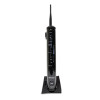Actiontec T2200H User Manual - Page 50
Dynamic DNS, allows the user to access a device a camera, for example from a remote location
 |
View all Actiontec T2200H manuals
Add to My Manuals
Save this manual to your list of manuals |
Page 50 highlights
VDSL2/GigE Wireless 11n Gateway 2. Click in the button next to Enable to activate. 3. Select the WAN IPv6 connection protocol from the drop-down list. 4. If applicable, activate DHCP 6rd Option Code and enter the 6rd MTU size in the text box. 5. Click Apply to save change. Dynamic DNS Dynamic DNS creates a dynamic IP address that is aliased to a static hostname, allowing a computer on the network to be more easily accessible from the Internet. Typically, when connecting to the Internet, the service provider assigns an unused IP address from a pool of IP addresses, and this address is used only for the duration of a specific connection. Dynamically assigning addresses extends the usable pool of available IP addresses, while maintaining a constant domain name. This allows the user to access a device (a camera, for example) from a remote location, since the device will always have the same IP address. When using Dynamic DNS, each time the IP address provided by the ISP changes, the DNS database changes accordingly to reflect the change. In this way, even though the IP address of the computer changes often, its domain name remains constant and accessible. 46















